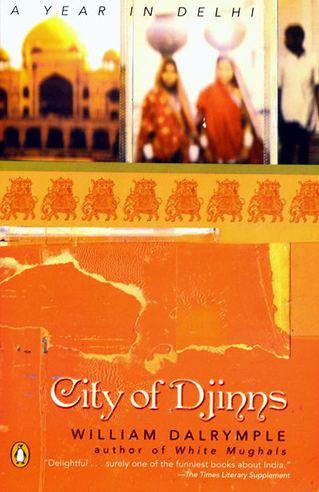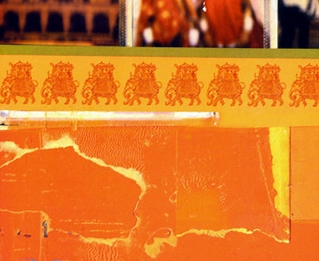The City of Djinns: A Year in Delhi
by: William Dalrymple
One man’s fascination and love of a city turns into a year, and honestly, most probably a lifetime, trying to understand that city. A year of “peeling back the layers” of Delhi. Right off the bat I have to say, William couldn’t have picked a better, more mysterious and historically more colorful city. Delhi could possibly have more history buried beneath it, surrounding it, held within its walls and still viewable in the streets than any other city on earth, not to mention that people still live there that were very much part of its recent turbulent history. William couldn’t have picked a harder task to record.
This book is actually described as a travel memoir type book but it is much much more than that and much less a memoir but more a history of Delhi. I would actually say it is maybe 20% memoir, 80% history, which is usually a really really bad sign for me, as I’m just not interested in reading history, and yet, this book was absolutely fascinating to me. I also have to say that I have been to Delhi and honestly, never knew that three-quarters of the material in this book even existed or happened to, or in, Delhi.  I just never knew and never really cared, or thought I didn’t, but I do. This is why I have to call William’s work here a literary masterpiece. This isn’t your average travel memoir. You can tell right from the get go that William did a lot of research and knows Delhi’s history very well, or as well as any one man can possibly know of it. I would usually close a book like this at about page fifty, but this is truly a masterpiece of writing.
I just never knew and never really cared, or thought I didn’t, but I do. This is why I have to call William’s work here a literary masterpiece. This isn’t your average travel memoir. You can tell right from the get go that William did a lot of research and knows Delhi’s history very well, or as well as any one man can possibly know of it. I would usually close a book like this at about page fifty, but this is truly a masterpiece of writing.
William takes a travel memoir and weaves a tale spanning two-thousand years into it. He walks a fine line almost perfectly, keeping the “travel memoir” side very active while informing the reader of what exactly made Delhi into what it is today. I never wanted to go back to Delhi until I read this book. I want to go back now. I want to see William’s Delhi. I want to explore the city. I want to see what he saw.
There are way to many topics to list, but William goes from spending time with the Eunuchs still there in the city today to something as mundane as trying to get a telephone line. He goes into detail about the architecture of the city, he goes to a wedding. He tells the tale of Skinner, a British soldier, goes to a pigeon fight. Explains the Partition, the “leftovers from Britain”. He befriends the Delhi-wallahs, he interviews the last living relative of Shah Jehan. William tells the story of Indira Gandhi, and the ramifications of her death, the festivals of Holi and Diwali. He weaves the tale of Fraser and Ibn Battuta. He tries to give all views on the Muslim, the Sikh and Hindu thoughts on the city. He looks for tales of Nizam-ud-Din, the hakim and the last remaining haveli’s in the city.
William tells of, as well possibly finding, the catacombs and tunnels believed to be underneath the city. He peels back the layers of seven cities built and destroyed over the ages. Tells the tale of Tughluk, when Delhi was moved, on three days notice, the whole city, only to have ninety percent of the residents die en route to the new location, Daulatabad.
This is a great one, and no matter how much money or how much fame William has received from this book, he has to be proud. A masterpiece in the thinking of Mark Twain almost (no, I’m not kidding) – it’s that good. He finds those Djinns, or the tale and legend of them, and holds the reader in awe all the way through. Almost insane how much information is in this book. I just never knew that I walked through this …and never knew. A book that gives you an authentic feel of Delhi throughout. It sucks you in and then spits you out, leaving the reader wanting more and asking the question “What the hell just happened?”. Three hundred and thirty nine pages of small text that you wish went on for twice that much, all the while thinking in the back of your mind that this is insane. It’s Delhi and that is what Delhi is. A history of a city that can truly be called the city of Djinns, because, well, that is insane, and that is Delhi. There is no reason for it being the way it is, but William gives you that reason. It’s insanity explained, and explained very well.
Bottom Line:
…If you are at all interested in the history of Delhi or India: The Highest Recommendation I can give
…If you have been to Delhi, or are interested in going: Highly Recommended
…If you are looking for a good travel memoir type read but not at all interested in history: Not Recommended
This is a tough one, because it is more history than memoir, yet it is, truly, a masterpiece of writing on India. If your looking more for just a personal experience type book though, and haven’t been or really plan on going to Delhi, this may not be one for you. That said, William has probably written one of the most comprehensive and informative books on the “thinking” of why Delhi is what it is …ever.
…so, if you’re a professor of Indian history: A MUST read for your class – never read better – read it yourself and see.
Help me keep traveling, reviewing, and taking pictures. If you want to buy this book, or any other book through Amazon, than click and buy through the photo above. Thank you!!! John





 It’s one of those places. The places that you see in pictures, on TV, on the internet, in books. One of those places that can’t really be fully understood until experienced. One of those places that you can spend all day, week, month or year researching and still never know what it is truly like. It can be imagined, but never really fully understood. You form expectations and conclusions based on your own mind and experiences, a picture that you can wrap your thinking around, but can never truly understand without going there, walking the streets, seeing and talking to the people, smelling the air, listening to the noise. It’s one of those places where all senses are needed, as well as assailed, at every twist, turn and corner.
It’s one of those places. The places that you see in pictures, on TV, on the internet, in books. One of those places that can’t really be fully understood until experienced. One of those places that you can spend all day, week, month or year researching and still never know what it is truly like. It can be imagined, but never really fully understood. You form expectations and conclusions based on your own mind and experiences, a picture that you can wrap your thinking around, but can never truly understand without going there, walking the streets, seeing and talking to the people, smelling the air, listening to the noise. It’s one of those places where all senses are needed, as well as assailed, at every twist, turn and corner. 

